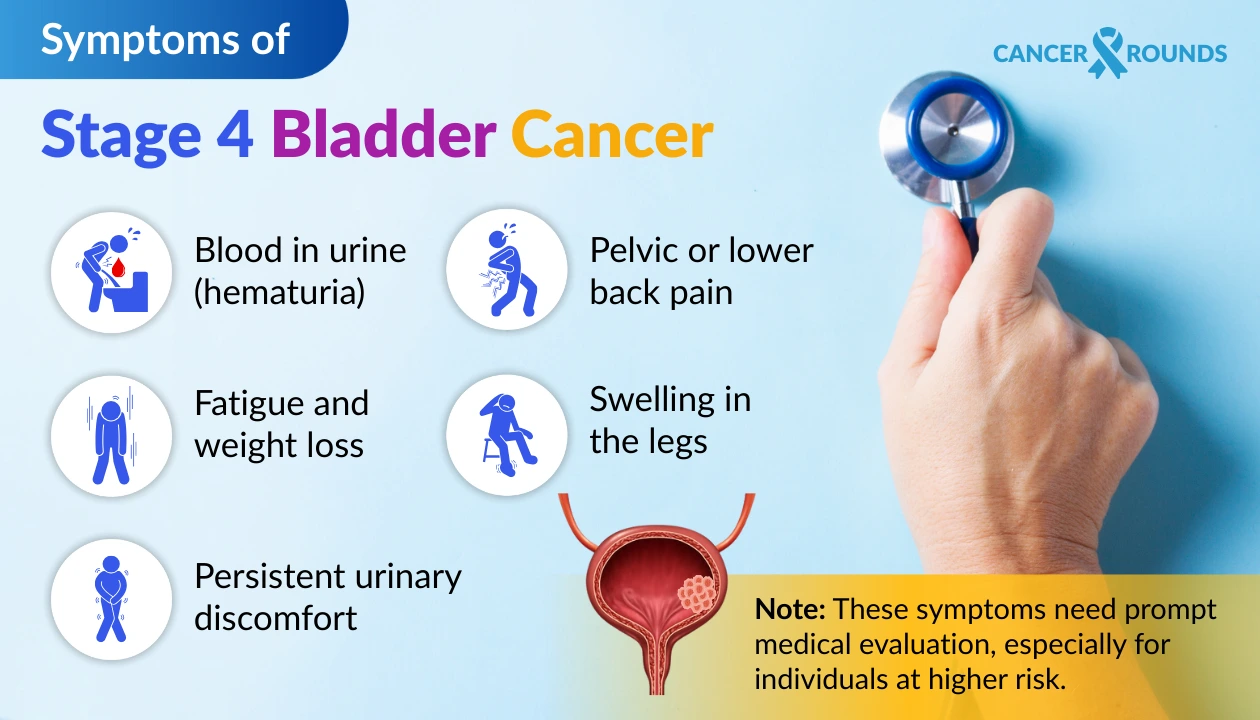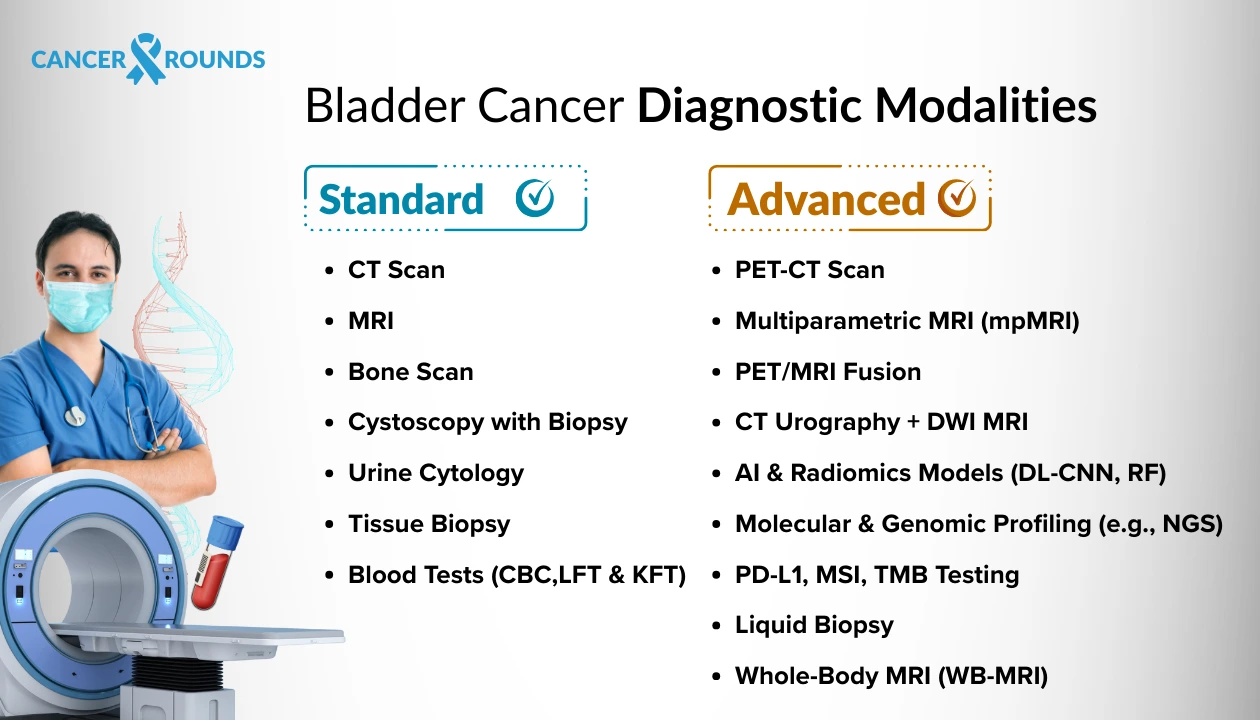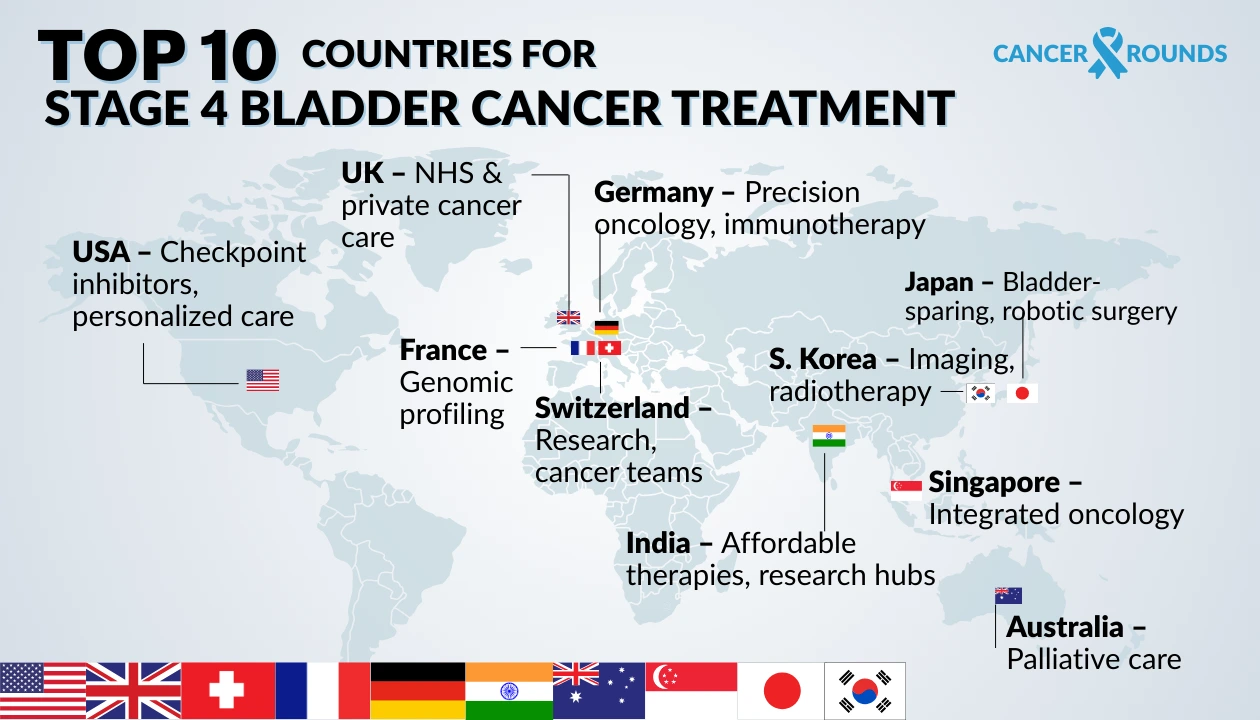Bladder cancer stage 4 stands as the most formidable and advanced form of this malignancy, defined by the relentless spread of cancer cells beyond the bladder’s confines into distant lymph nodes, the liver, lungs, and in some cases, the bones. As one of the most prevalent cancers worldwide, bladder cancer accounts for an estimated 573,000 new diagnoses annually and tragically claims over 200,000 lives each year.
At this metastatic stage, treatment becomes a complex battle and the prognosis considerably more guarded. One of the most pressing questions asked by patients and caregivers is, “Is stage 4 bladder cancer curable?” While a definitive cure remains rare, cutting-edge oncology has brought hope—significantly improving the stage 4 bladder cancer survival rate and enhancing quality of life.
According to the American Cancer Society, the 5-year survival rate for stage 4 bladder cancer hovers around 5–10%, influenced heavily by treatment responsiveness and the patient’s overall health. Without intervention, the stage 4 bladder cancer life expectancy without treatment may shrink to just a few months. However, the stage 4 bladder cancer 1 year survival rate varies considerably worldwide—elite cancer centers in regions such as Germany, the USA, and India report survival rates between 25–40%, far surpassing the global average.
Key Stage 4 Bladder Cancer Symptoms – Diagnostic Clues & Management Pathways
Identifying stage 4 bladder cancer symptoms promptly can be lifesaving, as early intervention in advanced disease helps guide treatment strategies and may improve the stage 4 bladder cancer survival rate. Below are the hallmark signs, their corresponding diagnostic approaches, and initial management considerations.
1. Blood in Urine (Hematuria)
5 easy Steps to Get Treated Abroad

Share Case Details

Get Expert Opinion and Hospital Quotes

Get Visa Invitation & Hotel Recommendations

Get Received At Airport and Start Your Treatment

Travel Back and Get Followups Through Us
- Diagnostic Approach: Urine cytology to detect malignant cells, cystoscopy for direct bladder visualization, and CT urogram to assess tumor spread.
- Management: Prompt referral to oncology; if bleeding is severe, bladder irrigation or cauterization may be necessary before systemic therapy.
2. Pelvic or Lower Back Pain
- Diagnostic Approach: MRI pelvis and spine to evaluate tumor infiltration into pelvic structures or bone metastases; PET-CT for overall disease mapping.
- Management: Pain control with analgesics, targeted radiotherapy to metastatic sites, and systemic therapy to reduce tumor burden.
3. Fatigue and Unexplained Weight Loss
- Diagnostic Approach: Comprehensive metabolic panel, complete blood count, and nutritional assessment; PET-CT to look for multi-organ spread.
- Management: Nutritional support, treatment of underlying anemia, and initiation of systemic cancer therapy to slow disease progression.
4. Swelling in the Legs (Edema)
- Diagnostic Approach: Doppler ultrasound to rule out deep vein thrombosis (DVT) and pelvic imaging to check for lymphatic obstruction by metastases.
- Management: Compression stockings, anticoagulants if clot is detected, and oncologic treatment to reduce tumor compression.
5. Persistent Urinary Discomfort
- Diagnostic Approach: Urinalysis to rule out infection, urine culture, cystoscopy for mucosal changes, and MRI to detect bladder wall invasion.
- Management: Symptom relief with antispasmodics, antibiotics if infection is present, and definitive oncologic treatment tailored to disease stage.
Each stage 4 bladder cancer symptom is a diagnostic clue pointing toward the extent and severity of disease. Linking symptom evaluation with advanced imaging, lab studies, and pathology not only confirms the diagnosis but also informs a precise treatment plan—whether the goal is tumor control, symptom relief, or both.

Advances in Diagnosing Stage 4 Bladder Cancer — Elevating Precision and Prognosis
In the rapidly evolving world of oncology, diagnosing stage 4 bladder cancer has become both more exact and more informative. These breakthroughs not only sharpen detection but empower tailored strategies that can significantly improve the stage 4 bladder cancer survival rate and overall patient outcomes.
Cutting-Edge Diagnostic Innovations
- PET/MRI Fusion Imaging
This hybrid technique merges the metabolic sensitivity of PET with the anatomical clarity of MRI, enabling detection of tiny nodal metastases—some under 1 cm—that often escape CT or MRI alone, enhancing accuracy in staging stage 4 bladder cancer, guiding treatment scope. - Advanced CT Urography & Diffusion-Weighted MRI
CT urography excels at highlighting subtle bladder abnormalities during the excretory phase, while diffusion-weighted MRI (DWI) and ADC mapping reveal the infiltration depth into the bladder wall, distinguishing muscle-invasive versus non-invasive disease. It Improves clarity on muscle infiltration and staging precision. - AI-Powered Predictive Models
Deep learning (DL-CNN) and radiomics-based algorithms analyze pre- and post-treatment CT scans to predict treatment response with a precision that rivals seasoned radiologists —streamlining decision-making and potentially reducing unnecessary interventions.
These advances redefine what’s possible in diagnosing stage 4 bladder cancer—making staging more precise, prognostic evaluation sharper, and treatment strategies smarter. Together, they pave the way for more personalized, effective care in even the most challenging cases.

Amid the intricate realm of oncologic care, a select cadre of nations stands at the forefront of stage 4 bladder cancer management, weaving together cutting-edge diagnostics, avant-garde therapeutics, and multidisciplinary expertise. These global leaders, revered for their relentless pursuit of innovation and uncompromising clinical precision, have transformed the prognosis landscape — offering patients not merely extended survival, but the promise of tailored, dignified, and hope-infused treatment journeys
Global Leaders in Stage 4 Bladder Cancer Treatment
While treatment quality varies worldwide, some countries are recognized as leaders in managing stage 4 bladder cancer.
Top 10 Countries for Advanced Care:
| Country | Famous Hospitals/ Centres | Cost (Advanced Care — Approximate) | 1-Year Survival (Stage 4, Approximate) | Local Tumour-Control (Ablative / ECT / TACE) |
| Germany | Charité – Universitätsmedizin Berlin; University Hospital Heidelberg / NCT Heidelberg | €8,000–€40,000+ (includes diagnostic workup, immunotherapy cycles, interventional procedures; TURBT approx. €8–12k, other therapies variable) | ~30–45% with modern systemic ± local therapy; some series report ~43% | ~70–80% in selected ablation/ECT cases for liver/pelvic metastases |
| India | Tata Memorial Centre (Mumbai), Apollo Hospitals, AIIMS | US$5,000–$25,000 (more affordable; immunotherapy available at reduced cycle costs) | ~25–40%, with outcomes improving due to greater immunotherapy and trial access | ~60–75% in select interventional/ablative cases; expanding rapidly |
| United States | MD Anderson, Memorial Sloan Kettering, Dana-Farber, Mayo Clinic | US$50,000–$250,000+ / year (immunotherapy drug costs often exceed $100k/year; total costs vary widely) | ~35–55% in treated cohorts; improvements seen with chemo/immunotherapy over recent years | ~60–80% for appropriate ablative/local techniques in selected metastases |
| United Kingdom | The Royal Marsden, Christie Hospital, Addenbrooke’s | £15,000–£100,000+ (NHS covers many costs for UK residents; private access varies) | ~30–50%, depending on access to treatments and trials | ~60–75% in multimodal bladder-preservation/local control studies |
| Japan | National Cancer Center Tokyo; major university hospitals with uro-oncology programs | ¥1,000,000–¥5,000,000+ (cost varies with systemic and procedural care) | ~30–50%, dependent on timing of detection and therapy | ~60–80% in selected ablation/CRT approaches |
| South Korea | Asan Medical Center, Samsung Medical Center | USD $15,000–$80,000+ (medical tourism packages for high-tech oncology care) | ~30–50%, outcomes comparable to other high-income countries | ~65–80% for targeted ablations/interventional approaches |
| Switzerland | University Hospital Zurich, Lausanne University Hospital (CHUV) | CHF 20,000–100,000+ (reflects advanced immunotherapy/targeted therapy costs) | ~35–50% in specialised centres | ~70–80% in experienced interventional oncology units |
| Singapore | National Cancer Centre Singapore (NCCS), Singapore General Hospital | US$15,000–$80,000+ (integrated oncology services; cost varies by package) | ~30–50% with multimodal care and trial participation | ~60–80% in selected ablative/interventional protocols |
| Australia | Peter MacCallum Cancer Centre, Royal Melbourne Hospital, Royal Prince Alfred Hospital | AUD $20,000–$120,000+ (cost varies between public and private care) | ~30–50%; strong emphasis on palliative and supportive care | ~60–75% in bladder-preserving radiotherapy/ablative series |
| France | Gustave Roussy, Institut Curie | €15,000–€90,000+ (includes genomic profiling, targeted therapy access) | ~30–50% with access to advanced drugs and trials | ~65–80% in high-expertise centres |
Germany, in particular, offers hope to patients asking, “Is bladder cancer curable at stage 4?” While cure remains rare, German oncology centers such as Charité – Universitätsmedizin Berlin and University Hospital Heidelberg specialize in advanced diagnostic imaging, precision-targeted treatments, and personalized therapy protocols.
Standard Treatment Methods for Stage 4 Bladder Cancer
For stage 4 bladder cancer, treatment focuses on controlling tumor growth, easing symptoms, and extending life.
- Chemotherapy – The mainstay, although some patients are ineligible due to kidney or health issues.
- Radiation therapy – Often palliative, aimed at pain and bleeding control.
- Surgery – Rarely used due to metastasis; more for symptom relief.
- Palliative care – Critical for enhancing comfort and quality of life.
While these treatments can improve the stage 4 bladder cancer survival rate, they often come with side effects and limited long-term control.
Innovative Treatments Offering New Hope
Advancements in oncology have brought promising alternatives:
Immunotherapy
In the sophisticated arsenal against stage 4 bladder cancer, immunotherapy emerges as a beacon of modern medicine—designed to awaken and fortify the body’s intrinsic defenses. By harnessing checkpoint inhibitors and precision biologics, it empowers immune cells to recognize and attack malignant tissues that once evaded detection. For metastatic cases, immunotherapy has shifted the narrative from purely palliative to potentially life-extending, offering select patients durable responses where conventional chemotherapy falters.
Dendritic Cell Therapy
Dendritic cell therapy represents a frontier in personalized oncology for stage 4 bladder cancer. By cultivating a patient’s own dendritic cells—nature’s master sentinels of the immune system—and priming them with tumor-specific antigens, physicians can orchestrate a bespoke immune response. This “cellular vaccination” educates the immune army to identify and relentlessly pursue bladder cancer cells, even those lurking in distant metastatic strongholds such as the liver or lungs.
Interventional Radiology – Precision Over Invasion
Interventional radiology offers a refined suite of minimally invasive procedures, granting stage 4 bladder cancer patients the benefits of local tumor control without the systemic toll of traditional therapies. Guided by advanced imaging, these procedures can precisely target primary and metastatic sites, preserving organ integrity and enhancing quality of life.
- Thermal Ablation: It deploys meticulously controlled heat to annihilate malignant tissue. Originally reserved for hepatic and pulmonary tumors, it has demonstrated encouraging outcomes in bladder cancer, with recurrence-free rates reaching up to 75% at one year when combined with complementary therapies.
- Cryoablation: It harnesses subzero temperatures to induce tumor necrosis while safeguarding the delicate architecture of the bladder wall. This balance of destruction and preservation has yielded progression-free survival rates of approximately 80% at six months, particularly valuable for patients in whom functional preservation is paramount.
- Electrochemotherapy: ECT marries the cytotoxic force of localized chemotherapy with transient electrical pulses that dramatically increase cellular drug uptake. In stage 4 bladder cancer metastases—especially in anatomically challenging pelvic sites—ECT has secured control over more than 70% of lesions. Beyond cytoreduction, it augments the body’s immune surveillance, making it a compelling partner to systemic immunotherapy.
Transarterial Chemoembolization (TACE)
TACE epitomizes targeted oncology in stage 4 bladder cancer care. By threading a catheter directly into the arteries feeding a tumor, clinicians can deliver concentrated chemotherapy while simultaneously obstructing the tumor’s blood supply, starving it of nutrients and oxygen. Clinical reports indicate tumor response rates of up to 60%, with markedly extended survival when paired with immunotherapy or radiation. Its localized delivery minimizes systemic toxicity, making TACE especially suitable for patients unable to withstand high-dose systemic regimens.
Role of Cancer Rounds in Treatment Journey for a Stage 4 Bladder Cancer Patient
At Cancer Rounds, we understand that a diagnosis of Stage 4 bladder cancer is not just a medical challenge, but an emotional and life-changing journey. Our mission is to be your medical facilitation partner in creating a care pathway that blends medical excellence with compassion, ensuring efficient local tumor control and an increased survival window while preserving your quality of life.
We help you make informed, confident decisions at every step by:
- Connecting you with the leading oncologist across globe
- Reviewing your reports in detail to understand your unique medical profile.
- Helping you choose the right country, hospital, and doctor best suited to your case.
- Coordinating online global second and third opinions with top oncologists.
- Tracking your treatment progress to ensure you stay on the best possible care path.
- Guiding you to advanced therapies—from surgery and radiation to targeted and immunotherapies—based on the latest evidence.
- Supporting you and your loved ones emotionally and logistically throughout the journey.
Bottom Line
For patients facing stage 4 bladder cancer, the journey is undeniably challenging. However, the stage 4 bladder cancer life expectancy is not fixed—advances in Germany and other top countries, including India, are improving both survival and quality of life.
While statistics such as the stage 4 bladder cancer 1 year survival rate and stage 4 bladder cancer life expectancy without treatment can sound discouraging, real-world patient stories show that innovative therapies, multidisciplinary care, and access to global expertise can make a meaningful difference.
 Chat on WhatsApp
Chat on WhatsApp













